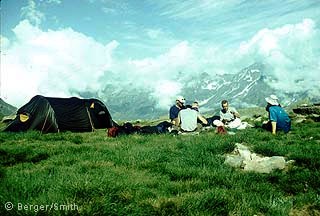For their entire length, the Pyrenees follow the border between France and Spain, running from the Atlantic Ocean to the Mediterranean Sea. Although lower in elevation than the Alps, the Pyrenees are extremely steep and dramatically serrated. As a result hiking trails in the Pyrenees are both challenging and scenic.
Three major trails traverse the French and Spanish Pyrenees: The Grand Randonnee 10 (GR-10), the Grand Randonnee 11 (GR-11) and the Haute Route Pyrennean (HRP). There’s a lot of scenery compressed into these approximately 50-day hikes. (Figure around 600 miles of up-and-down-and-around-the-mountain hiking, although no one seems to know exactly.)
Hiking Routes in the Pyrenees Mountains
 |
| A campsite in the Haute Pyrenees |
- The GR-10 (Grande Randonnee 10) is the most popular route across the Pyrenees. It runs on the French side of the border. Of the three main trans-Pyrenees routes, the GR-10 is the best-blazed and the easiest to follow. However, while easiest logistically, it is physically difficult because the trail on the French side of the Pyrenees gets much more rain than the Spanish side, so the weather is more challenging. Also, the GR-10 is more demanding than the two others because of the long and steep descents and ascents into and out of the many precipitous north-south running valleys on the French side of the mountains. However, the GR-10 does offer the possibility of sleeping in a town or a refuge every night, reducing or eliminating the need to carry camping gear.
- The GR-11 (Grande Randonnee 11) follows the French system of blazing and numbering, but it runs through the Spanish Pyrenees, on the south side of the border. The route is not thoroughly blazed, and can sometimes be difficult to follow, but it is extremely beautiful. Although very few people hike the entire GR-11 from the Atlantic to the Mediterranean, the trail can be crowded with day-hikers and weekenders, especially in the popular Spanish national parks.
- HRP (Haute Route Pyrenean) is the High Adventure Route, which stays in the highest, most remote country as much as possible. It is usually blazed in yellow, although it sometimes follows the red-and-white blazed GR-10 or the GR-11. It goes through the middle of Andorra, the tiny country that occupies a small part of the Franc-Spanish border. When hiking in the remote central part of the Pyrenees on the HRP, hikers must carry all their camping gear, because towns and refuges are too far apart. Route finding is the major challenge, as the blazing is sporadic.
In all three cases, trail quality varies. The routes include paved roads, farm-roads, footpaths, and cross-country travel (mostly on the HRP). The Pyrenees are precipitous, and many of the trails are very steep, which reduces the number of miles it is possible to hike in a day.
Seasonal Information for Hiking in the Pyrenees
 |
| Crossing a snowfield in August |
cause of the high elevations, thru-hiking the trail is a July-August venture. Part of the trails near both coasts have a longer hiking season – June to September, and indeed, may be more pleasant in late spring and early fall because they won’t be as hot. In the Basque country near the Atlantic Ocean, weather can be hot and humid. Near the Mediterranean, the climate is hot and dry. In between, in the higher mountains, the weather is extremely variable, with potentially violent electrical storms. At the higher elevations, there may be patches of snow, but ice axes and crampons are not usually necessary in summer.
Most thru-hikers hike from the Atlantic to the Mediterranean, although the trail can certainly be hiked in both directions. A complete traverse takes about 50 days.


